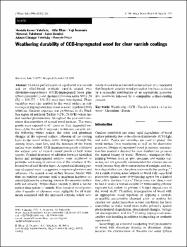| dc.contributor.author | Yalınkılıç, Mustafa Kemal | |
| dc.contributor.author | İlhan, Rifat | |
| dc.contributor.author | Imamura, Yuji | |
| dc.contributor.author | Takahashi, Munezoh | |
| dc.contributor.author | Demirci, Zafer | |
| dc.contributor.author | Yalınkılıç, Ahmet Cihangir | |
| dc.contributor.author | Peker, Huseyin | |
| dc.date.accessioned | 2020-11-20T16:45:32Z | |
| dc.date.available | 2020-11-20T16:45:32Z | |
| dc.date.issued | 1999 | |
| dc.identifier.issn | 1435-0211 | |
| dc.identifier.uri | https://doi.org/10.1007/BF00538961 | |
| dc.identifier.uri | https://hdl.handle.net/20.500.12809/5438 | |
| dc.description | WOS: 000084669300010 | en_US |
| dc.description.abstract | Outdoor performances of a polyurethane varnish and an alkyd-based synthetic varnish coated over chromium-copper-boron (CCB)-impregnatecl Scots pine (Pinus sylvestris L.) and chestnut (Castanea sativa Mill.) [10 (R) x 100 (T) x 150 (L) mm] were investigated. These varnishes were also applied to the wood surface as sole coatings or impregnated into wood as water-repellent (WR) solutions. Outdoor exposure was performed in the Black Sea region of northern Turkey (41 degrees N, 39.43 degrees E) where humid weather predominates throughout the year and accelerates decomposition of coated wood surfaces. The wood panels were exposed at 45 degrees south on their tangential surfaces. After 9 months of exposure to summer, autumn, and the following winter season, the color and glossiness changes of the exposed surface, adhesion of the coating layer to the wood surface, water absorption through the coating layers, mass loss, and the hardness of the board surface were studied. CCB impregnation greatly stabilized the surface color of varnish-coated panels of both wood species. Gradual decreases of adhesion between varnished layers and preimpregnated surfaces were attributed to probable weakening of interactions at the interface of the treated wood and the film layer. A superficial cleaning process of treated wood is suggested to improve glossiness and adhesion. The coated wood surface became harder with time on outdoor exposure until a maximum hardness occurred followed by softening, whereas the uncoated surface softened steadily. Polyurethane varnish yielded a harder surface than synthetic varnish. Mass losses of wood panels after 9 months of exposure were negligible for all treatments compared with the untreated controls, which were totally discolored and eroded on the surface. It is concluded that long-term exterior wood protection has been achieved by a successful combination of an appropriate preservative treatment followed by a compatible surface-coating process. | en_US |
| dc.item-language.iso | eng | en_US |
| dc.publisher | Springer-Verlag Tokyo | en_US |
| dc.item-rights | info:eu-repo/semantics/openAccess | en_US |
| dc.subject | weathering | en_US |
| dc.subject | CCB | en_US |
| dc.subject | varnish coating | en_US |
| dc.subject | exterior wood | en_US |
| dc.subject | chromium | en_US |
| dc.subject | boron | en_US |
| dc.title | Weathering durability of CCB-impregnated wood for clear varnish coatings | en_US |
| dc.item-type | article | en_US |
| dc.contributor.department | MÜ, Teknik Eğitim Fakültesi | en_US |
| dc.contributor.institutionauthor | İlhan, Rifat | |
| dc.identifier.doi | 10.1007/BF00538961 | |
| dc.identifier.volume | 45 | en_US |
| dc.identifier.issue | 6 | en_US |
| dc.identifier.startpage | 502 | en_US |
| dc.identifier.endpage | 514 | en_US |
| dc.relation.journal | Journal of Wood Science | en_US |
| dc.relation.publicationcategory | Makale - Uluslararası Hakemli Dergi - Kurum Öğretim Elemanı | en_US |


















